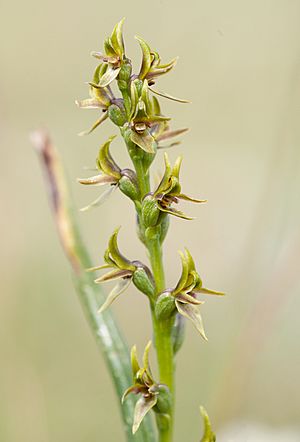Alpine leek orchid facts for kids
Quick facts for kids Alpine leek orchid |
|
|---|---|
 |
|
| Prasophyllum tadgellianum growing near Mount Hotham | |
| Scientific classification | |
| Synonyms | |
|
Prasophyllum alpinum R.Br. |
The alpine leek orchid (scientific name: Prasophyllum tadgellianum) is a special type of orchid that grows naturally in the Snowy Mountains of Australia and in Tasmania. It has a single stiff leaf and pretty, often scented, greenish-brown or reddish-brown flowers. These flowers grow close together on a strong stem.
Contents
What Does the Alpine Leek Orchid Look Like?
The alpine leek orchid is a plant that grows from the ground. It is a perennial plant, meaning it lives for more than two years and often comes back each year. It is also deciduous, which means it loses its leaves at certain times. This plant has an underground tuber (a bit like a potato) and a single, stiff, dark green leaf shaped like a tube. This leaf is about 10 to 20 centimeters (4 to 8 inches) long and 4 to 8 millimeters (0.16 to 0.31 inches) wide at its base.
Each plant grows a strong flowering stem about 5 to 8 centimeters (2 to 3 inches) tall. On this stem, you'll find between ten and twenty flowers packed closely together. The flowers are usually dark greenish-brown. They have a special part called a labellum that can be greenish, pink, or white. These flowers often have a light scent.
Orchid flowers are unique! In the alpine leek orchid, the flowers are upside down. This means the labellum is above the column (the part that holds the reproductive organs) instead of below it. The ovary (where seeds develop) is about 4 millimeters (0.16 inches) long, and the petals are about 5 millimeters (0.20 inches) long.
The side sepals (leaf-like parts protecting the flower) are about 6 millimeters (0.24 inches) long. They are joined together for most of their length and form the very top part of the flower. The top sepal is shaped like an egg or a spear and is also about 6 millimeters (0.24 inches) long. The labellum has a sharp bend in the middle and often has a wavy edge. It is also covered with a raised area called a callus.
These orchids bloom from January to March. Unlike many other orchids in its group, the alpine leek orchid does not need a bushfire from the previous summer to make it flower.
How Did This Orchid Get Its Name?
This special orchid was first officially described in 1922 by a botanist named Richard Sanders Rogers. He first called it Prasophyllum frenchii var. tadgellianum. He found a sample of the plant on Mount Hotham. The sample was collected by Alfred James Tadgell, and the orchid's specific name, tadgellianum, honors him. The description was published in a scientific paper called Transactions and Proceedings of the Royal Society of South Australia. The very next year, Rogers decided that this variety was unique enough to be its own species.
Later, in 1944, another botanist named Herman Rupp thought that P. tadgellianum was the same as another orchid, P. alpinum. He wrote this in his book Orchids of New South Wales. However, in 1996, David Jones, another botanist, looked at them again. He confirmed that P. tadgellianum was indeed a separate species, commonly found in southeastern Australia. He also noted that P. alpinum is a different species found only in Tasmania.
Where Does the Alpine Leek Orchid Live?
The alpine leek orchid likes to grow in high places, usually above 1,000 meters (3,300 feet) in elevation. You can find it in grassy areas in the mountains and subalpine regions, often where the ground is moist or wet.
In New South Wales and Victoria, it grows south of the Brindabella Range. In Tasmania, it is found only in a few specific spots. These include areas near Cradle Mountain and close to Bastion Bluff in the Great Western Tiers.
Is the Alpine Leek Orchid Safe?
This orchid is considered "Rare" in Tasmania. This means it is protected under the Tasmanian Threatened Species Protection Act 1995. Being listed as "Rare" helps make sure people work to protect it and its habitat.
See Also
- Prasophyllum alpinum, commonly known as the alpine leek orchid, a species of orchid endemic to Tasmania.

